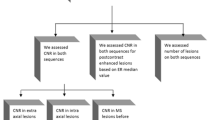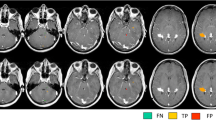Abstract
Our purpose was to evaluate the role of magnetization transfer and image subtraction in detecting more enhancing lesions in brain MR imaging of patients with multiple sclerosis (MS). Thirty-one MS patients underwent MR imaging of the brain with T1-weighted spin echo sequences without and with magnetization transfer (MT) using a 1.5 T imager. Both sequences were acquired before and after intravenous injection of a paramagnetic contrast agent. Subtraction images in T1-weighted sequences were obtained by subtracting the pre-contrast images from the post-contrast ones. A significant difference was found between the numbers of enhanced areas in post-gadolinium T1-weighted images without and with MT (p=0.020). The post-gadolinium T1-weighted images with MT allowed the detection of an increased (13) number of enhancing lesions compared with post-gadolinium T1-weighted images without MT. A significant difference was also found between the numbers of enhanced areas in post-gadolinium T1-weighted images without MT and subtraction images without MT (p=0.020). The subtraction images without MT allowed the detection of an increased (10) number of enhancing lesions compared with post-gadolinium T1-weighted images without MT. Magnetization transfer contrast and subtraction techniques appear to be the simplest and least time-consuming applications to improve the conspicuity and detection of contrast-enhancing lesions in patients with MS.






Similar content being viewed by others
References
Smith ME, Stone LA, Albert PS (1993). Clinical worsening in multiple sclerosis is associated with increased frequency and area of gadopentetate dimeglumine-enhancing magnetic resonance imaging lesions. Ann Neurol 33:480–490
Miller DH, Albert PS, Barkhof F (1996). Guidelines for the use of magnetic resonance techniques in monitoring the treatment of multiple sclerosis. Ann Neurol 39:6–16
McFarland HF, Frank JA, Albert PS (1992). Using gadolinium enhanced magnetic resonance imaging lesions to monitor disease activity in multiple sclerosis. Ann Neurol 32:758–766
Sardanelli F, Losascco C, Iozzelli A, Renzetti P, Rosso E, Parodi RC, Bonetti M, Murialdo A (2002) Evaluation of Gd-enhancement in brain MR of multiple sclerosis: image subtraction with and without magnetization transfer. Eur Radiol 12:2077–2082
Molyneux PD, Tofts PS, Fletcher A (1998). Precision and reliability for measurement of change in MRI lesion volume in multiple sclerosis: a comparison of two computer assisted techniques. J Neurol Neurosurg Psychiatry 65:42–47
Huot P, Dousset V, Hatier E, Degreze P, Carlier P, Caille JM (1997). Improvement of post-gadolinium contrast with magnetization transfer. Eur Radiol 7 [Suppl 5], S174–S177
Rovaris M, Filippi M (2000) Magnetization transfer imaging. J Neurol Sci 172:S3–S12
Poser CM, Paty DW, Scheinberg L, McDonald WI, Davis FA, Ebers GC, et al (1983). New diagnostic criteria for multiple sclerosis: guidelines for research protocols. Ann Neurol 13:227–231
Κurtzke JF (1983) Rating neurological impairment in multiple sclerosis. An expanded disability status scale (EDSS). Neurology 33:1444–1452
Runge VM, Kirsch E, Thomas GS (1991). High dose application of gadolinium chelates in magnetic resonance imaging. Magn Reson Med 22:358
Filippi M, Carpa R, Campi A (1996). Triple dose of gadolinium DTPA and delayed MRI in patients with benign multiple sclerosis. J Neurol Neurosurg Psychiatry 60:526–530
Filippi M, Horsfield MA, Rovaris M (1998). Intraobserver and interobserver variability in schemes for estimating volume of brain lesions on MRI images in multiple sclerosis. AJNR Am J Neuroradiol 19:239–244
Mehta RC, Pike GB, Enzmann DR (1995) Improved detection of enhancing and non-enhancing lesions of MS with magnetization transfer. AJNR Am J Neuroradiol 16:1771–1778
Finelli DA, Hurst GC, Gullapali RP, Bellon EM (1994) Improved contrast of enhancing brain lesions on post-gadolinium T1-weighted spin-echo images with use of magnetization transfer. Radiology 190:553–559
Author information
Authors and Affiliations
Corresponding author
Rights and permissions
About this article
Cite this article
Gavra, M.M., Voumvourakis, C., Gouliamos, A.D. et al. Brain MR post-gadolinium contrast in multiple sclerosis: the role of magnetization transfer and image subtraction in detecting more enhancing lesions. Neuroradiology 46, 205–210 (2004). https://doi.org/10.1007/s00234-003-1146-2
Received:
Accepted:
Published:
Issue Date:
DOI: https://doi.org/10.1007/s00234-003-1146-2




